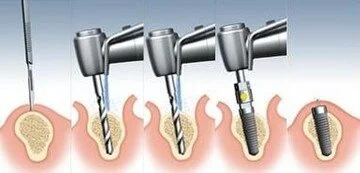What to Expect if You're Getting a Dental Implant
What Are Dental Implants?
Dental Implants are a type of artificial replacement for your lost teeth. They consist of a screw-like structure that is placed in the bone, with a structure that is placed over it that appears in your mouth, over which a dental cap (or crown) is placed. They have been used in the industry for more than 40 years and are considered the most successful way of replacing missing and lost teeth.
What are implants made of?
Dental implants are made from Titanium, which is the material used to build airplanes and rockets. Titanium is a biologically acceptable material that causes no side effects. Recently, Zirconium –Which has been used to make dental crowns for more than 10 years- has been recently introduced to be used as a dental implant material, as it is very inert and enhances bone formation. The process is still under undergoing studies and investigations at the moment.
The implant process occurs in phases.
The implant process occurs in phases.
Who can benefit from dental implants and who can’t?
Patients who lost one or more teeth due to decay, trauma or other causes are considered candidates to receive dental implants. There is no limit to the number of dental implants that can be placed in your mouth. A patient who lost all of his teeth can receive dental implants to replace all the lost teeth. However, dental implants are not indicated for all cases. Patients who suffer from some health problems such as diabetes or gland disorders should not receive implants as the success rate is decreased significantly. Also, when the bone of your jaw is not sufficient, there is no place to insert the implant, and therefore the dentist will suggest other options, as dental bridges or removable dentures.
How is the implant placed in the mouth?
The process of placing a dental implant is multi-step one. Perhaps the most important step is diagnosis, and figuring out if you are a candidate or not. This process requires first a clinical approach, where the condition of your mouth is checked by the dentist. Oral hygiene, the space available for implant placement, and the condition of the bone and gums are all factors to be considered. Another important aspect of diagnosis is X-rays. A Panoramic x-ray, or more recently a 3D scan (called cone beam CT) can assess the quality and quantity of bone. Most dentists will also take replicas of your mouth to form what is called a diagnostic cast, from which some more data can be obtained.
After diagnosis is done, The surgical phase begins. The dentist will make a small opening in your gums to expose the bone (sometimes this step can be ignored, and the drilling starts directly). Then a sequence of drills is used to create an opening in the bone, that is slightly smaller than the size of the implant. The implant is then placed in the opening with a little bit of pressure so that it doesn’t move, then stitches are made to close the opening of the gums.
After 3 to 6 months (according to the quality of the bone), begins the prosthetic phase, in which the overlying crown is made.This period allows the bone to heal and attach firmly to the implant. After this period, the dentist will take a replica of your mouth with the implant, send it to the laboratory, which forms the crown and sends it back to the dentist, who cements it on the implant placed in your mouth.
If I can’t receive implants, what are my options?
If you are not a candidate for implants, the dentist usually will suggest two other types of replacement. One is the dental bridge, which is a fixed type, and the other is the denture, which is a removable type.
What are the dangers of implant placement?
Dental implants carry virtually no risk, and have next to no side effects. In some rare cases, a piece of your bone can break during the process, which poses no threat to your health. The worst thing that can happen, is that the implant may not attach to the bone, and the result is that it falls out of your mouth. In that case, the dentist will remove the old implant and place a new one almost immediately. As you can see, the risks of dental implants are very minimal, so they should be the choice for replacing missing teeth whenever possible.
If you need a gentle, caring dental team, please call Jennifer Fineberg’s office at (623) 362-2550. We’ll give you the very best dental care we can!

